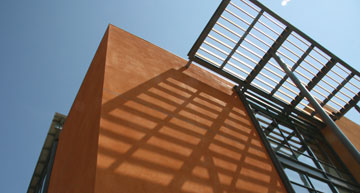Volume 26 · Number 1 · Fall 2008
The Second Century

(Photo: Eric Rohr/UC Davis)
In 1922, campus planners saw an alfalfa field and envisioned a campus heart, a central gathering place, a Quad. Today planners see a historic Quad that still defines UC Davis, and they envision a way to build on its special character to tie together a campus now grown to near 900 buildings and more than 5,000 acres.
As UC Davis looks back and celebrates its first 100 years, planners are looking to create a framework that will serve the campus well for the next 100. Their goal is to ensure that the special nature of the campus is preserved—that all its new neighborhoods share the important core elements of open space, park-like landscaping, and bike and pedestrian-friendly ways, and that all areas stay connected. To do that, a new comprehensive master plan—dubbed the “Centennial Plan”—calls for a new library plaza that will link the library to the Quad and, in turn, serve as a pivot point to all areas of the campus.
“We’re returning to the strength of the campus framework established at the founding and extending it to reconnect all of the spaces to the south and west of the Quad, from the Memorial Union to the new entry area at the Mondavi Center, from a new library plaza on the west side of Shields to the Silo student area and the sciences district,” says Bob Segar, assistant vice chancellor for campus planning. “We want to connect back to the Quad from all points.”
The line of historic oaks along the west side of the Quad will be extended with new landscaping in front of the library’s west-facing entrance, providing a connection to the tree-lined walkway that currently extends from the library to Mrak Hall. The passageway will then continue south all the way to the Mondavi Center and Buehler Alumni and Visitors Center and the new buildings there: the just-completed Robert Mondavi Institute for Wine and Food Science; a hotel/conference center and a new home for the Graduate School of Management now under construction; and eventually a new art museum.
The vista from the library to the west will be opened up as well, with the removal of the more than 40-year-old “Temporary Buildings” west of Walker Hall. They will be replaced with another tree-lined walk that will front three new buildings for student services, including a new Student Community Center. These “storefront buildings,” says Segar, will have signs hung out front, and their ground-floor services will be easily accessible to the foot-traffic traveling between the library and the Silo’s student gathering area.
“This will be like our village square, our campus downtown. We want to make it an urban walking street, dense with energy and student activity,” says Segar.
Throughout the core campus, bridges, walkways and landscaping will connect all four points, and pedestrian access—which in places hasn’t kept pace with bike access—will be strengthened. An important component of this linking landscape will be the arboretum with its series of pathways that draw people into campus from the Davis community and that pass through virtually every academic neighborhood on campus. An ambitious plan called UC Davis GATEways (Gardens, Arts and The Environment) calls for new amenities, gardens, teaching landscapes, public art and academic outreach centers to create an “arts walk” and to better highlight the academic areas along the way.
“As you walk along the arboretum, you go by all these academic buildings, but you have no idea what goes on inside,” says Segar. In the future, a series of outreach centers and outdoor teaching gardens and performance spaces will allow visitors to interact with students and faculty and learn about the work of the university.
The Centennial Plan also includes improvements to the Quad itself, including a Centennial Walk to be unveiled on Oct. 15, and a new entryway into the south side of campus from Interstate 80, which will feature a teaching vineyard.
“The Centennial Plan is our roadmap to the future,” says Segar. “It shows our capacity for growth, but it also highlights what we value in our existing environment. We want to protect the elements that give the UC Davis campus its special character and connect our new buildings and gathering places to that existing framework. Connect, connect, connect. Faculty, staff and students, visitors, community members and friends, all using the physical environment to connect to UC Davis. ”
— Teri Bachman
